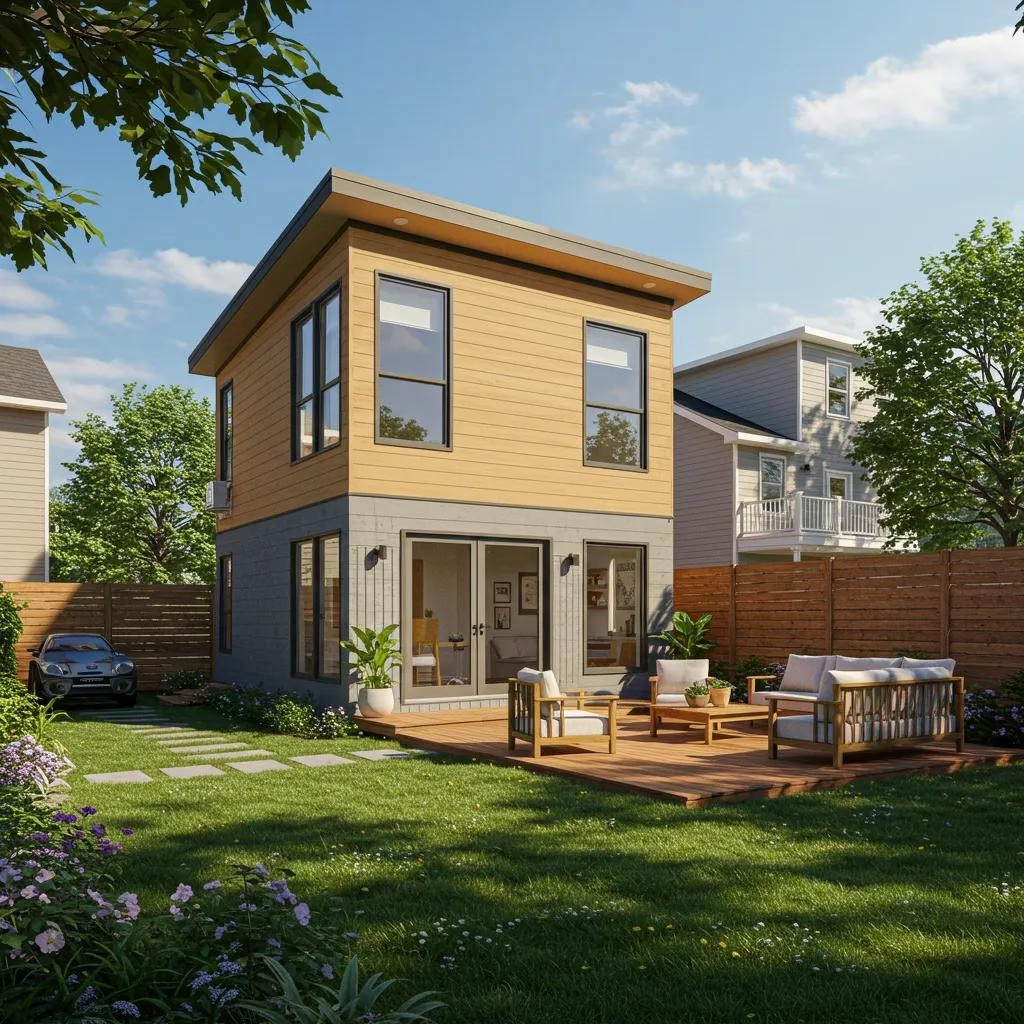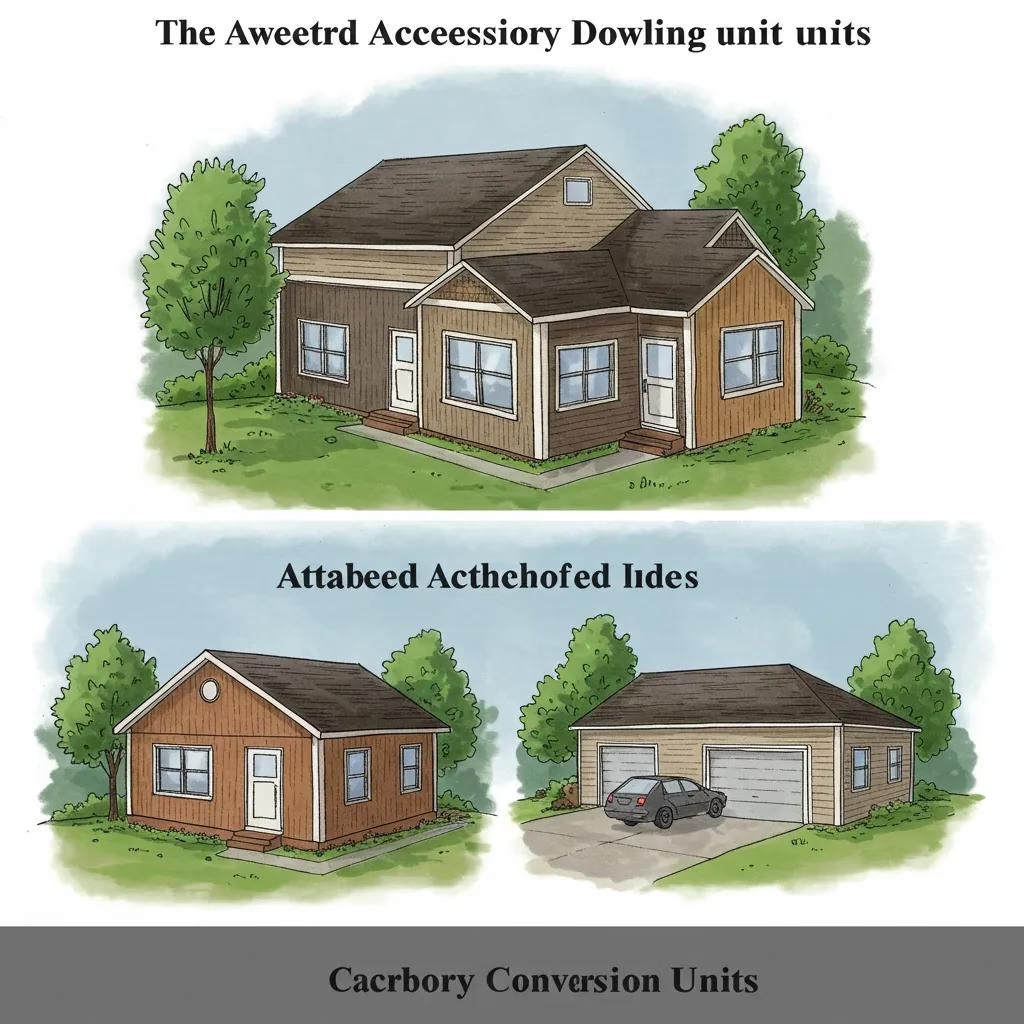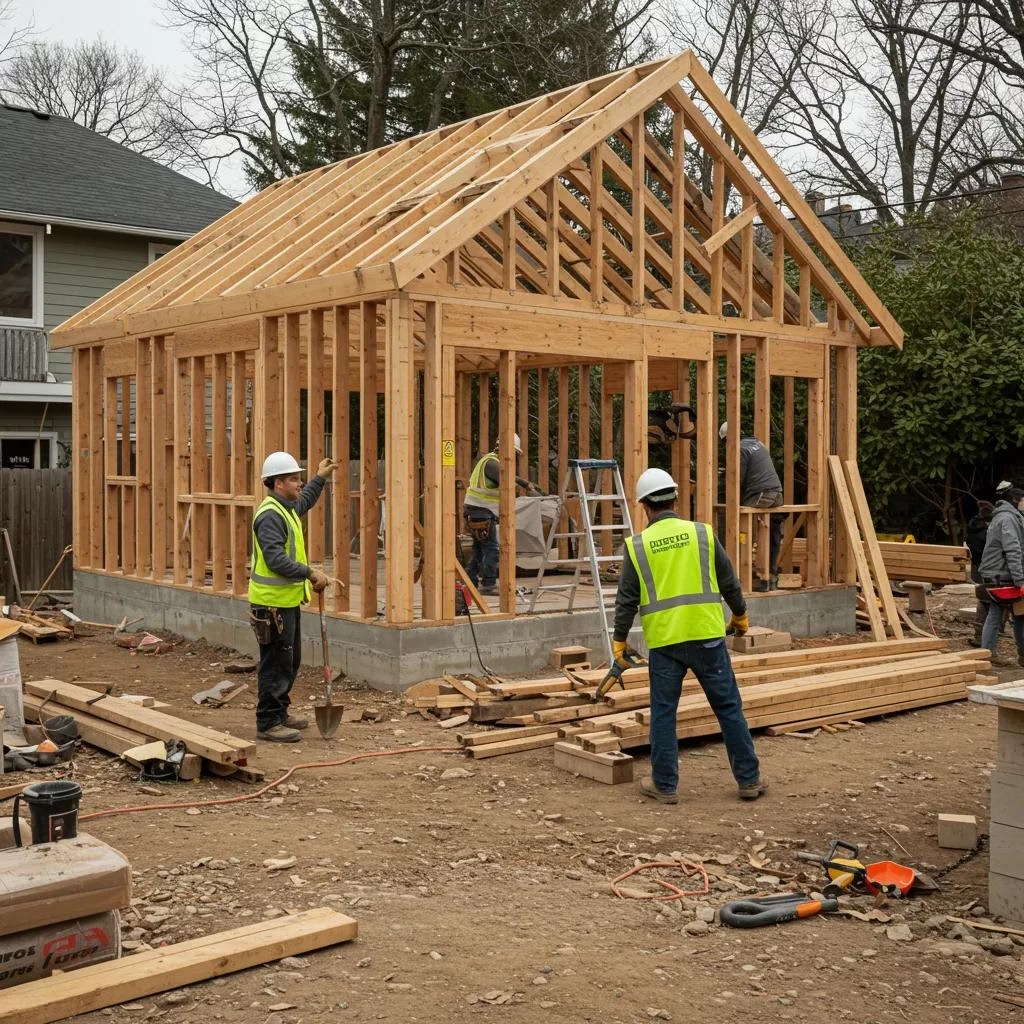
ADU Builders Sunnyvale: Expert Home Remodeling and Accessory Dwelling Unit Construction to Book Your Appointment
An accessory dwelling unit (ADU) is a secondary living space on a single-family lot—detached, attached, or converted from an existing structure—and ADU builders Sunnyvale homeowners rely on deliver design, permitting and construction expertise for these projects. This article explains why building an ADU in Sunnyvale makes strategic sense, the ADU types available, how local permitting is navigated, the end-to-end construction process, cost and financing options, and sustainable smart-design choices to maximize value. Many homeowners face uncertainty about regulations, timelines and realistic budgets; this guide breaks those barriers into actionable steps so you can plan with confidence. Readers will find comparison tables, clear permit timelines, cost line-item breakdowns, and lists of financing and sustainability strategies tailored to Sunnyvale conditions in 2025. After clarifying benefits and practical steps, the article highlights how expert Sunnyvale ADU builders streamline permitting and manage projects so you can move from concept to completion.
Why Build an ADU in Sunnyvale? Key Benefits of Home Remodeling with ADU Builders
An ADU increases usable square footage and creates long-term economic and lifestyle value by adding rental income potential, improving resale appeal, and enabling flexible living arrangements. In Sunnyvale’s housing market, an ADU can transform underused yard or garage space into a high-demand dwelling that appeals to renters, extended family, or a home office, delivering both monthly revenue and capital appreciation. ADU construction also allows homeowners to diversify household use without moving, improving quality of life while leveraging existing property equity. The next paragraphs show specific financial mechanisms, occupancy assumptions and practical living configurations that illustrate these benefits.
ADUs boost property value and create ongoing income streams in ways that are measurable and adaptable to homeowner goals. Understanding the financial mechanics helps decide which ADU type fits best and prepares you for realistic budgeting and permitting steps that follow.
ADUs offer flexible living solutions that adapt to changing household needs and demographic shifts by providing private, self-contained units suitable for seniors, young adults, or guests. These flexible solutions are the next focus because practical layouts and accessibility features determine how well an ADU meets family needs.
ADUs provide privacy, accessibility and independence for multigenerational living while remaining attached to the primary home. Thoughtful design preserves privacy for both households and supports caregiving, rental, or home-office use with separate entrances and independent utility connections.
ADUs increase property value and generate rental income through direct appraisal uplift and market comparables that reflect additional livable square footage. Homeowners should weigh occupancy rates, local rent levels, and expected maintenance when modeling ROI, and those calculations lead into the comparative decision of which ADU type best aligns with a given property.
How Does an ADU Increase Your Property Value and Rental Income?
An ADU increases property value by converting unused yard or garage space into rentable square footage, which appraisers and buyers increasingly recognize as durable value-add features. Rental income estimates depend on unit size, finish level and local demand; in high-demand Bay Area markets, a well-designed ADU frequently yields meaningful monthly cash flow that offsets financing costs and raises net operating income. Appraisal adjustments typically consider comparable rental units and replacement cost; as a result, adding a compliant ADU can shift buyer valuations upward. Reviewing potential rent ranges and vacancy assumptions is essential before committing to a specific ADU scope and leads naturally to considerations about unit layout and accessibility.
What Flexible Living Solutions Do ADUs Offer for Multi-Generational Families?
ADUs support multigenerational households by offering private kitchens, bathrooms and sleeping areas while maintaining proximity to the main house for caregiving and social connection. Design choices—like single-story layouts, grab bars, zero-threshold showers and accessible doorways—allow aging family members to live independently with safety and dignity. For younger adults or in-law use, ADUs provide autonomy without the financial burden of separate homeownership, and units can convert to rental properties if family needs change. Planning for adaptable finishes and future-proof utility connections makes the ADU a long-term asset rather than a single-use addition.
What Types of ADUs Can Sunnyvale Homeowners Build? Detached, Attached, and Garage Conversion Options Explained

ADU types fall into clear categories—detached backyard cottages, attached additions, and garage conversions—each with different footprints, cost implications and permitting nuances. Selecting a type depends on lot size, setbacks, existing structures and homeowner objectives like privacy vs. lower cost. The following table provides a concise comparison of typical size, average cost range, pros and cons to help homeowners quickly assess which option aligns with their property and budget. After the table, detailed pros and cons of detached units and conversions will clarify tradeoffs in design flexibility and timeline.
| ADU Type | Typical Size | Average Cost Range | Pros and Cons |
|---|---|---|---|
| Detached ADU (backyard cottage) | 400–1,200 sq ft | Moderate–High depending on finish and utilities | Pros: Privacy, layout flexibility, higher rent potential. Cons: New foundation/utility runs increase cost and timeline. |
| Attached ADU (addition/wing) | 300–1,000 sq ft | Moderate | Pros: Shared walls reduce construction cost, easier utility connections. Cons: Less privacy, may impact main home layout. |
| Garage Conversion ADU | 200–600 sq ft | Low–Moderate | Pros: Lower cost, faster timeline by reusing structure. Cons: Limited space, potential parking trade-offs. |
This comparison clarifies how footprint, budget and desired privacy influence ADU selection and prepares homeowners to explore the specific advantages of each approach.
What Are the Features and Advantages of Detached ADUs?
Detached ADUs offer independent living with full separation of utilities and entrances, which supports higher rental rates and stronger privacy for occupants. Because they are standalone, detached units allow more design freedom—two-bedroom layouts, private outdoor spaces, and flexible siting to maximize solar access or privacy screening. The tradeoff is higher construction cost and longer timelines due to foundation work, utility extensions and potential site grading; however, the final product often delivers greater income potential and occupant satisfaction. Considering these factors helps homeowners decide whether the higher upfront investment aligns with long-term financial objectives and leads into how attached and conversion options compare on cost and timeline.
How Do Attached ADUs and Garage Conversions Maximize Space and Functionality?
Attached ADUs and garage conversions leverage existing structure and utility connections to reduce construction time and cost while creating practical living spaces close to the primary residence. Attached additions can be designed to flow from the primary home, improving accessibility and preserving usable yard, whereas garage conversions reuse an existing footprint to create compact, efficient units. Designers focus on maximizing natural light, storage and flexible furniture solutions to make smaller footprints livable. These lower-cost options often achieve faster approvals and earlier occupancy, which is attractive to homeowners prioritizing speed and budget control.
How Do Sunnyvale ADU Builders Navigate Permitting and Local Regulations?
Sunnyvale ADU builders specializing in local projects understand zoning rules, setback requirements and the documentation needed for permit submissions and can significantly reduce approval time.
Navigating permits requires knowledge of lot coverage, height limits, parking exemptions and utility connection standards; builders streamline the process by preparing accurate site plans, engineering documents and code-compliant drawings. The table below lists key permits or requirements, who issues them and typical timelines so homeowners can anticipate the administrative path and reduce surprises. After the table, an explanation of state-level streamlined permitting and local practices illustrates how experienced builders accelerate approvals.
| Permit / Requirement | Issuing Authority / Typical Timeline | Action Needed / Typical Time |
|---|---|---|
| Building permit | City Planning/Building Dept — 2–8 weeks review | Submit plans, structural and energy compliance documents; respond to plan check comments |
| Zoning review / setback confirmation | City Planning — 1–3 weeks | Provide site plan, property survey and compliance notes |
| Utility connection approvals | Water/Sewer/Electrical providers — 2–6 weeks | Coordinate service upgrades, trenching and inspection scheduling |
| Fire and life-safety clearance | Fire Dept — 1–3 weeks | Meet access and egress, detect/suppression requirements if applicable |
Understanding these permit types and expected timelines clarifies the administrative steps and prepares homeowners for the next operational topic: how streamlined permitting and professional project management shorten the path from design to build.
Research into local regulations highlights the complexities and importance of understanding specific county requirements for ADU development.
Accessory Dwelling Unit Permitting and Completion in Santa Clara County
The research question guiding this study is: How have local jurisdictions within Santa Clara County amended their General Plans, General Plan housing elements, and zoning ordinances to align with the new state legislation on Accessory Dwelling Unit development enacted on January 1, 2020? Furthermore, can the development of Accessory Dwelling Units be quantified as low-income housing units to support the achievement of Santa Clara County’s Regional Housing Needs Allocation (RHNA) objectives?
The Permitting and Completion of Accessory Dwelling Units (ADUs) in Santa Clara County to Satisfy the Regional Housing Needs Allocation, 2021
What Are the Key Sunnyvale Zoning Laws and Setback Requirements for ADUs?
Key zoning considerations for Sunnyvale ADUs include minimum setbacks from property lines, maximum lot coverage and potential parking exemptions for qualifying units; these standards determine where and how large an ADU can be. Common rules allow reduced parking requirements for ADUs or permit in-lieu options but still require precise site measurements and compliance documentation. Builders familiar with local planning practice prepare property surveys and demonstrate compliance to avoid delays, and homeowners should verify current local updates through the city planning department. Recognizing these rules early helps shape design decisions and reduces iteration during plan checks.
How Does the Streamlined Permitting Process Expedite Your ADU Project?
Recent state laws and local process improvements in 2025 emphasize streamlined permitting for ADUs, including pre-approved plan options and faster plan checks for compliant designs, which can materially shorten approval timelines. Experienced Sunnyvale ADU builders leverage pre-approved plans when suitable and maintain checklists that align submittals with city expectations to avoid common plan-review rejections. Builders also coordinate engineering, energy compliance and utility interconnections proactively so inspections and sign-offs fall into predictable windows. These efficiencies reduce homeowner burden and support on-time starts for construction, moving the discussion from approvals into the practical construction phases.
What Is the ADU Construction Process with Expert Sunnyvale Builders? From Consultation to Completion

The ADU construction process begins with a site consultation and program assessment, moves through design and permit submission, then proceeds into phased construction with quality checkpoints and final inspections. A clear process reduces surprises and establishes milestones for budgeting, staging and temporary accommodations, and this section outlines deliverables and typical sequencing.
The numbered list that follows isolates core phases so homeowners can visualize the timeline and responsibilities; the paragraphs below expand on consultation, design deliverables and on-site craftsmanship that ensure durable results.
- Initial consultation and site evaluation to define program, budget and constraints.
- Design development and permit-ready drawings with engineering and energy compliance.
- Construction phases: site prep, foundation, framing, MEP installation, finishes, inspections.
- Final inspections, occupancy clearance and handover with warranty and maintenance guidance.
This stepwise view clarifies responsibilities and expectations and sets the stage for a deeper look at what the initial consultation includes and how on-site phases preserve quality.
How Does the Initial Consultation and Custom Design Tailor Your ADU?
During the initial consultation the builder documents homeowner goals, budget, site constraints and preferred uses, then translates these inputs into conceptual layouts and preliminary cost estimates. Deliverables typically include a program summary, conceptual floor plans, and a rough schedule that align design ambitions with permitting realities and site conditions. This phase identifies must-have features—accessibility, separate utilities or high-efficiency systems—and guides choices between detached, attached or conversion paths. A well-executed consultation produces permit-ready directions that reduce redesign cycles and accelerate the subsequent plan-check process.
What Are the Steps for Construction, Quality Craftsmanship, and Project Completion?
Construction unfolds in clearly defined phases: site preparation and foundations, framing and enclosure, mechanical-electrical-plumbing installations, interior finishes and exterior landscaping, followed by inspections and final occupancy.
Quality craftsmanship depends on consistent supervision, trade coordination and stage inspections that verify structural, weatherproofing and MEP systems before finishing work begins. Builders enforce punch lists, manufacturer-approved install practices and third-party inspections when required so the final handover includes documentation and occupancy certificates.
Clear communication of these milestones keeps homeowners informed and enables a smooth transition to occupancy or rental use.
How Much Does Building an ADU Cost in Sunnyvale? Financing Options and Cost Breakdown
Costs to build an ADU in Sunnyvale vary by ADU type, finish level and site complexity, but major line items—design, permits, construction, utilities and contingency—consistently account for the bulk of expenditures. The table below breaks down cost components, what they cover and approximate ranges as a share of the total budget so homeowners can prioritize savings or upgrades. After the table, average cost ranges by ADU type and practical financing options are presented to help readers plan funding and schedule a cost-review appointment.
| Cost Component | What It Covers | Estimated Range (% of total) |
|---|---|---|
| Design & engineering | Architectural drawings, structural/MEP engineering | 5–12% |
| Permits & fees | City plan checks, utility permits, impact fees | 3–8% |
| Construction hard costs | Foundation, framing, finishes, MEP installation | 55–75% |
| Utility connections | Sewer, water, electrical upgrades and trenching | 5–15% |
| Sitework & landscaping | Grading, access, exterior finishes | 2–8% |
| Contingency | Unforeseen site conditions, change orders | 5–10% |
This line-item breakdown helps homeowners understand where funds are allocated and where design choices can control cost, and it leads into average ranges by ADU type and financing approaches.
What Are the Average Costs for Detached, Attached, and Garage Conversion ADUs?
Average cost ranges vary by scope: detached ADUs typically command the highest budgets due to new foundations and utility runs, attached additions sit in the middle, and garage conversions are usually the most budget-friendly by reusing structure. Key variables influencing price include lot access for equipment, extent of utility upgrades, finish level and unforeseen site conditions. Sample budget scenarios help homeowners align expectations: modest finishes and efficient footprints reduce per-square-foot cost, whereas high-end finishes, custom systems or complicated site logistics increase total project costs. Understanding these dynamics informs financing choices and whether to phase work or choose pre-approved plan options to lower design expenses.
Which Financing Solutions and Incentives Are Available for Sunnyvale ADU Projects?
Common financing pathways for ADUs include home equity lines of credit (HELOC), renovation or construction loans, and specialized ADU loan products; each has tradeoffs in terms, closing speed and documentation. Some homeowners use cash-out refinancing to consolidate project costs while others apply for construction-to-permanent loans that convert once the unit is complete. Incentive programs and local grants occasionally exist to promote accessory units or sustainable features; builders often help assemble documentation for loan underwriting and incentive applications to streamline approval.
Evaluating financing in tandem with permit timelines reduces holding costs and enables an executable build schedule.
If you’re ready to evaluate cost and financing for your property, book an appointment to schedule a personalized cost-review and financing consultation that leverages local permitting expertise and end-to-end project management.
How Do Sustainable and Smart ADU Designs Enhance Home Remodeling in Sunnyvale?
Sustainable and smart ADU designs reduce operating costs, improve occupant comfort and increase long-term property value by combining energy-efficient systems, durable materials and connected controls. Integrating high-performance insulation, energy-efficient windows and HVAC, plus solar-ready roofs and LED lighting, lowers energy consumption and can qualify projects for incentives. Smart-home integrations—thermostats, locks, lighting and monitoring—improve convenience for renters and owners while enabling remote management of energy and security. The following list highlights specific sustainable and smart features that deliver measurable benefits and points to design choices that balance upfront cost with long-term savings.
- High-efficiency HVAC and insulation: Reduce heating and cooling loads and lower monthly utility bills.
- Solar-ready roof and electrical panel planning: Simplify future renewable installations and increase net-zero potential.
- LED lighting and efficient appliances: Decrease energy use and improve occupant comfort.
- Smart thermostats and remote monitoring: Provide energy optimization and convenient rental management.
These features improve lifecycle cost and occupant appeal; the next paragraph explains material choices and payback considerations for homeowners weighing sustainability investments.
What Eco-Friendly Materials and Energy-Efficient Features Are Used in ADU Construction?
Eco-friendly ADU builds use high-R insulation, low-E windows, efficient HVAC, LED lighting and durable, low-VOC finishes to minimize energy use and indoor emissions while maximizing longevity. Selecting materials with proven durability reduces maintenance over time and improves life-cycle cost; for example, specifying long-lasting exterior cladding and quality windows can reduce replacement cycles and increase net operating income for rental units. Designers often balance upfront premium for efficient systems against projected energy savings to identify payback horizons that match homeowner priorities. These material and system choices dovetail with smart-home integrations that optimize energy performance and tenant comfort.
How Can Smart Home Technology Be Integrated into Your ADU Design?
Smart home technology in ADUs can be scaled from starter packages—smart thermostats and keyless locks—to advanced systems including whole-home energy monitoring, automated lighting and integrated security. Integration during construction is more cost-effective than retrofits: rough-in for smart wiring, placing conduits for future sensors and specifying compatible panels simplifies later upgrades. Smart features reduce operational friction for rentals by enabling remote management of access, temperature and energy use while improving tenant satisfaction. Starting with a prioritized list of required capabilities and scaling over time ensures the ADU remains technologically current without over-investing at the outset.
For homeowners who want to move forward with a sustainable, smart ADU and need guidance on permitting, design or financing, book an appointment to discuss how end-to-end project management and local permitting expertise can accelerate your project from concept to occupancy.
